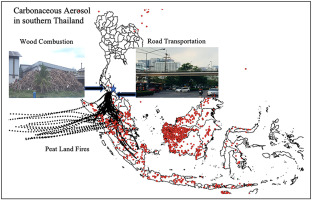Environmental Pollution ( IF 8.9 ) Pub Date : 2020-01-21 , DOI: 10.1016/j.envpol.2020.114031 Worradorn Phairuang 1 , Muanfun Inerb 2 , Masami Furuuchi 3 , Mitsuhiko Hata 4 , Surajit Tekasakul 5 , Perapong Tekasakul 6

|
In this study, size-fractionated particulate matters (PM) down to ultrafine (PM0.1) particles were collected using a cascade air sampler with a PM0.1 stage, in Hat Yai city, Songkhla province, southern Thailand during the year 2018. The particle-bound carbonaceous aerosols (CA) as elemental carbon (EC) and organic carbon (OC) were quantified with the thermal/optical reflectance method following the IMPROVE_TOR protocol. The concentrations of different temperature carbon fractions (OC1-OC4, EC1-EC3 and PyO) in the size-fractionated PM were evaluated to discern OC and EC correlations as well as those between char-EC and soot-EC. The results showed that biomass burning, motor vehicle, and secondary organic aerosols (SOC) all contributed to the size-fractionated PM. The OC/EC ratios ranged from 2.90 to 4.30 over the year, with the ratios of PM2.5-10 being the highest, except during the open biomass burning period. The concentration of CA was found to increase during the pre-monsoon season and had its peak value in the PM0.5-1.0 fraction. The long-range transport of PMs from Indonesia, southwest of Thailand toward southern Thailand became more obvious during the pre-monsoon season. Transported plumes from biomass burning in Indonesia may increase the concentration of OC and EC both in the fine (PM0.5-1.0 and PM1.0-2.5) and coarse (PM2.5-10 and PM>10) fractions. The OC fraction in PM0.1 was also shown to be significantly affected by the transported plumes during the pre-monsoon season. Good OC and EC correlations (R2 = 0.824–0.915) in the fine particle fractions indicated that they had common sources such as fossil fuel combustion. However, the lower and moderate correlations (R2 = 0.093–0.678) among the coarser particles suggesting that they have a more complex pattern of emission sources during the dry and monsoon seasons. This indicates the importance of focusing emission control strategies on different PM particle sizes in southern Thailand.
中文翻译:

在泰国南部,大小分级的碳质气溶胶低至PM0.1:局部和远距离迁移影响。
在这项研究中,使用具有PM 0.1的级联空气采样器收集了分离成超细颗粒(PM 0.1)的颗粒大小的颗粒物(PM)。阶段,于2018年期间在泰国南部宋卡府的合艾市进行。通过IMPROVE_TOR的热/光反射法对颗粒结合的碳质气溶胶(CA)作为元素碳(EC)和有机碳(OC)进行定量协议。对大小分级的PM中不同温度碳组分(OC1-OC4,EC1-EC3和PyO)的浓度进行了评估,以区分OC和EC相关性以及char-EC和烟灰EC之间的相关性。结果表明,生物质燃烧,机动车和二次有机气溶胶(SOC)均造成了颗粒级分的PM。全年的OC / EC比率在2.90至4.30之间,PM 2.5-10的比率最高,除了露天生物量燃烧期。发现CA的浓度在季风前季节增加,并且在PM 0.5-1.0的峰值处出现。在季风前季节,PM从泰国西南部的印度尼西亚向泰国南部的远程运输更加明显。来自印度尼西亚生物质燃烧的运输烟羽可能会增加精细级分(PM 0.5-1.0和PM 1.0-2.5)和粗级分(PM 2.5-10和PM > 10)中OC和EC的浓度。在季风前季节,PM 0.1中的OC分数也受到运输羽流的显着影响。良好的OC和EC相关性(R2 = 0.824–0.915)中的细颗粒级分表明它们具有共同的来源,例如化石燃料燃烧。但是, 较粗颗粒之间的相关性较低和中等(R 2 = 0.093–0.678),表明它们在旱季和季风季节的排放源格局更为复杂。这表明将排放控制策略集中在泰国南部不同PM粒度上的重要性。



























 京公网安备 11010802027423号
京公网安备 11010802027423号